Authored by:
Robert Koenigsberger, Managing Partner & Chief Investment Officer
Mohamed A. El-Erian, Chair
Petar Atanasov, Director & Co-Head of Sovereign Research
Kathryn Exum, Director & Co-Head of Sovereign Research
March 30, 2022
Decoding the Global Macro Environment: A Top-down Perspective and the Related Implications for Emerging Markets Heading into 2Q 2022
The global operating environment for emerging markets has worsened in the last few weeks. The challenges we discussed in our previous quarterly have been aggravated by adverse economic and financial spillovers from Russia’s invasion of Ukraine and the resulting humanitarian tragedy. Our thoughts and prayers go out to all those who have lost loved ones, the millions that have been displaced, and the many more who have seen their lives and livelihoods totally upended.
The Russia-Ukraine war has moved global stagflation from a tail risk to more of a baseline. It has amplified the challenge facing the Federal Reserve, particularly as it scrambles to catch up to inflation that has been grossly mis-characterized for too long. It increases the likelihood of significant dispersion in economic performance and unsettling financial volatility.
Russia and Ukraine are looking at an economic depression, albeit with an important difference. The eventual recovery in Ukraine is likely to be faster, especially as it will be supported by significant international financial assistance. Russia faces years of economic and financial dislocations. Also, with international trade and payments sanctions unlikely to be removed any time soon, it will have to rewire many of its economic and financial links.
Turning to Europe, the continent faces an uncomfortably high risk of recession, especially due to its gas dependency on Russia. Countries geographically close to Ukraine are particularly exposed – as they help accommodate the largest forced displacement of people in such a short period of time.
China and the United States will feel the stagflationary winds. Their ability to navigate them well depends on the avoidance of policy mistakes.
Already, the market spotlight is on the Federal Reserve which increasingly finds itself in a lose-lose situation that is largely of its own making. Either it hits the policy brakes hard in order to contain inflationary expectations and risk what should have been an avoidable recession or it taps the brakes and risks having an inflation problem persist well into 2023 which, again, was once avoidable.
All of this translates into a challenging environment for commodity-importing emerging economies. High commodity prices, particularly for food and energy, compound the challenges faced on account of lower global growth, higher borrowing costs, and more volatile financial flows. These high prices confront many of these countries with the difficult question of how much to let flow through to consumers and how much to subsidize. It is a question that, for fragile countries, goes well beyond economics and finance, also involving tricky geo-political and socio-political aspects. Payment arrears become more probable in the handful of countries lacking robust balance sheets.
When combined with our previously expressed concerns about the structural vulnerability of market liquidity, investors should expect continued volatility to offer both heightened risks and interesting opportunities. More than ever, detailed credit work, differentiation, and resilient structuring will prove essential.
Themes Influencing Investment Decisions in 2022
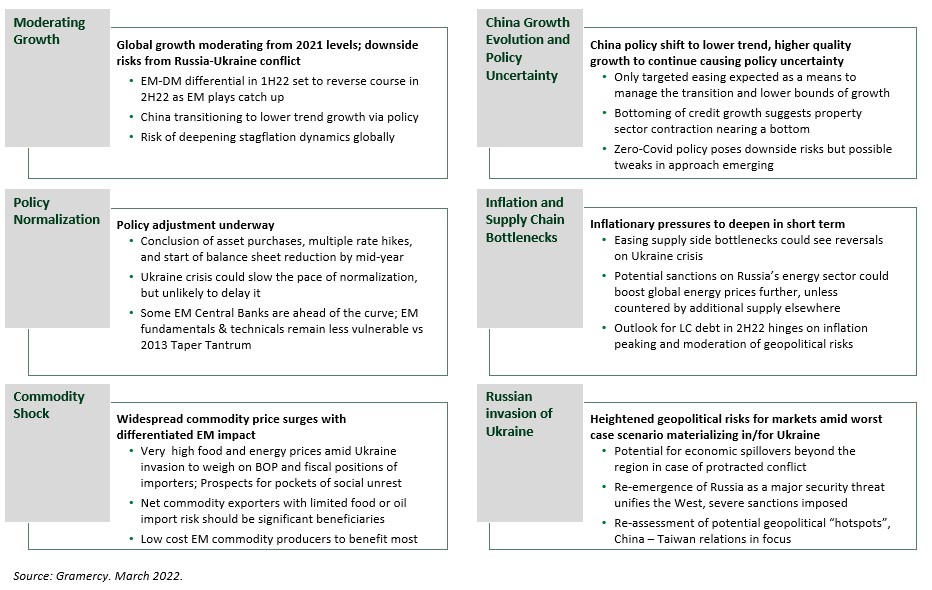
Global growth moderation on geopolitical shock
The unexpected cascade of events following Russia’s invasion of Ukraine in mid-February should lower global growth relative to previous expectations. This is due to significant inflationary pressures amid agriculture and energy trade disruption as well as financial system exposure concentrated in Europe. The estimated drag on global growth at the time of writing ranged between roughly 0.25% to 1.0% but has the potential to become more substantial if the duration of the conflict extends, absent partial resolution to the associated supply shocks. At the current juncture, the global economy should still be supported by the next iteration of reopening as economic disruption from the virus continues to dissipate as reflected by robust global PMI data in February and pent-up services unleashed. This combined with policy easing in China, cautious policy tightening in the U.S., and the possibility of stabilization in distortions from the likely persistent geopolitical crisis could alleviate downside pressure as the year progresses, but we believe this is unlikely in the very near-term.
We expect net commodity exporters with low linkages to CIS and Europe to have more resilient growth dynamics while net commodity importers could face greater constraints. In China, the National People’s Congress (NPC) held in early March unveiled an ambitious 2022 growth target of 5.5% above the market consensus growth forecast of 5.2%. While we still see risk for near-term headwinds to Chinese growth as outlined in our last quarterly report on property sector weakness and an official zero-tolerance approach to COVID, the authorities’ strong track record to engineer and achieve growth in line with its goals supports the view that weakness will be met with further easing as well as possible increased prospects for either formal or informal loosening of its zero-tolerance strategy. This should help drive improvement in EM-DM growth differentials as the year progresses albeit with differentiation depending on the path of the Russia-Ukraine war.
Exhibit 1: Global growth rate still near historical average despite current negative drag assumptions from war
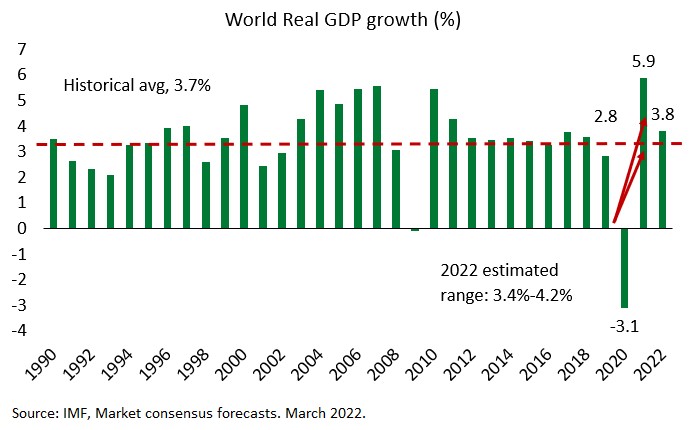
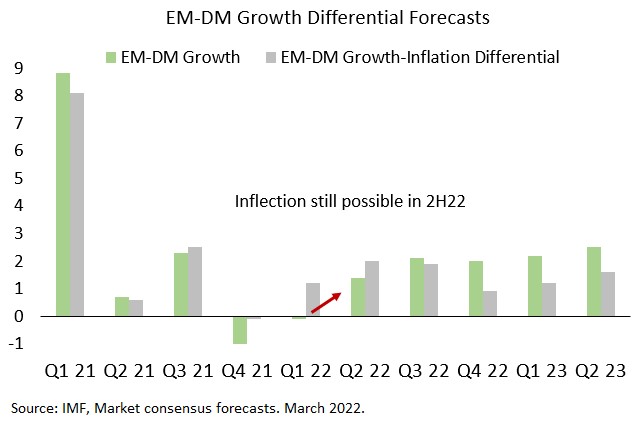
Inflationary pressures are likely to deepen in short-term on Ukraine conflict; Fed liftoff began in March and expected to continue on pace
The full-scale invasion of Ukraine unleashed by President Putin in late February, a fat-tail event risk from the perspective of many investors and political analysts, sent shock waves through global markets and dramatically altered the outlook for a number of important macro variables. Inflation dynamics, by far the top concern for market participants pre-Ukraine war, are set to experience further upside pressures across most economies, mainly via significantly higher global energy, commodities and food prices.
Russia is one of the world’s largest oil and gas producers (11% and 17% of total global production, respectively) and severe western sanctions against its energy sector have triggered materially higher energy prices worldwide. When it comes to global food supply chains, the Russian invasion is likely to lead to the largest wheat shortage in history. Together, Russia and Ukraine account for around a quarter of wheat and 20% of corn produced globally. This raises the specter of potential bread/food shortages and rapid price increases which could be particularly detrimental for economic and social stability in already vulnerable EM jurisdictions, especially those with strong trade linkages to Russia and/or Ukraine.
The energy and food price shocks stemming from the war came at a moment when inflationary pressures in many EM and DM economies appeared to be finally starting to moderate/peak after the inflationary shock created by the COVID-19 pandemic. Now investors and policymakers need to recalibrate their expectations yet again and “stagflation” risks appear to have increased for a number of global economies.
Different regions will be impacted to varying degrees; naturally those in geographic proximity to the conflict zone are more exposed. For example, Europe’s reliance on Russian gas makes it particularly vulnerable to lower exports and higher prices following Germany’s halt of Nord Stream 2. In that context, economists have already revised year-end-2022 inflation forecasts for the Euro area materially higher. More broadly, it is generally estimated that a 20% rise in oil prices would increase global headline inflation by 25-50 bps, which is significant given already elevated starting levels.
This is the environment in which the Fed lift-off happened in mid-March. The FOMC increased the policy rate by 25 bps, the first hike since 2018. Meanwhile, the Bank of England (BOE) tightened for a third time in its ongoing cycle and the ECB seem set for its own lift-off in early 2H22.
Federal Reserve officials forecast six additional hikes this year, a year-end 2022 rate of 1.9%, and a terminal rate for this cycle of 2.8% next year. Against this backdrop, market consensus has shifted to a 50 bps hike in May, which appears to be where some key FOMC voters also stand. Geopolitical tensions create uncertainties, but the Fed policymakers appear to feel the need to be proactive in the face of higher inflationary pressures. This also increases the likelihood that markets will see the Fed seeking to shrink its balance sheet more swiftly than anticipated. Chair Powell has said that the Fed expected to reduce the size of its balance sheet at ‘a coming meeting’.
Exhibit 2: Stronger inflationary pressures as result of the Russia-Ukraine war likely to prompt the systemic central banks to taper asset purchases and reduce monetary policy accommodation more swiftly

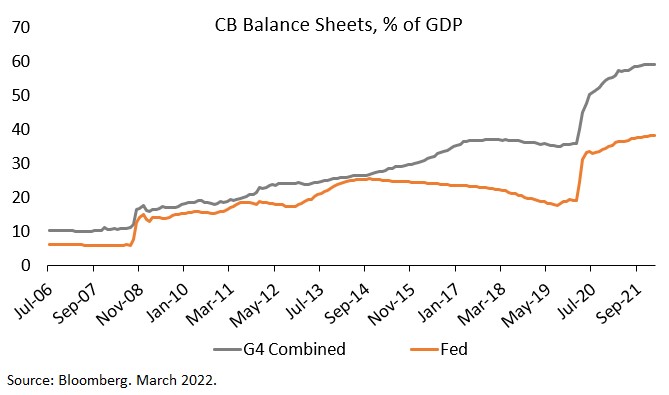
In the event the hit to global growth and inflation dynamics from the war in Ukraine proves more significant and prolonged than currently anticipated, the probability of the downside scenario we warned about in our 1Q outlook is likely to increase. In such a scenario, as inflation accelerates while GDP growth falters, many economies, both developed and emerging, might face “stagflation”, i.e., low/declining growth and elevated/accelerating inflation. Central banks might be forced to increase interest rates faster than expected, putting the brakes on already fragile economic recoveries and disrupting markets accustomed to a long-lasting paradigm of abundant, cheap liquidity and accommodative monetary policy. EM as an asset class would suffer significant headwinds and volatility under such a scenario. As such, credit quality differentiation, based on deep bottom-up analysis of fundamental metrics (one of our key themes in 2021), seems to be even more relevant now as we look toward 2Q 2022.
The Russia-Ukraine conflict highly fluid with various spillover effects
More than a month into Russia’s full-scale invasion of Ukraine, a negotiated end of the conflict still appears unlikely in the near-term, despite what we believe is a more substantive diplomatic engagement between the two sides that began at the end of the quarter in Turkey. The military situation on the ground as of the time of writing can be described as “mixed” at best from Russia’s perspective given Kremlin’s stated goals of the invasion, which in our view points to continuing fighting regardless of parallel diplomatic discussions. The Zelensky Administration has signaled flexibility on the issues of neutrality and reconsidering the goal of joining NATO enshrined in Ukraine’s constitution, but Russia’s territorial demands over Crimea and the independence of the two separatist regions in Eastern Ukraine remain unacceptable to Kyiv. As such, we think that market optimism about a potential resolution in the near-term is premature for the time being. We believe that President Putin retains rather maximalist objectives and expectations for his military gamble in Ukraine. Given the already catastrophic impact for Russia’s economy, increasing global isolation, and even some initial tentative uncertainty about his domestic political standing over the medium-term, he appears to have little choice but to remain “fully invested” and continue pushing for a better position on the ground. As such, unless there is a significant breakthrough in the Istanbul negotiations and signals emerge that a direct meeting between Presidents Zelensky and Putin is in the cards, we believe that the war will linger in the near future, remaining a key market factor in 2Q.
China’s response to the war will remain under close watch by U.S. policymakers as well as investors in the context of latent tensions regarding Taiwan and further global splintering of financial, technological, and economic systems. The Chinese authorities have taken a mixed approach thus far to Russia’s actions, failing to condemn the invasion but urging de-escalation with the potential to act as a mediator at some point in the future. However, we do not expect this to occur unless there is a more material probability of sustained progress on ceasefire and resolution. While it is not our base case for China to take actions that blatantly violate U.S. sanctions or provoke the U.S., given its desire to maintain stability in a politically sensitive year, we do not rule out developments that increase tensions. This may include increased frequency of Chinese military incursion into Taiwanese defense airspace in the near-term, which have been a common occurrence in recent years, or deepening of China’s strategy for unification outlined as part of the Party Congress in October. This combined with prospects for China as a foreign policy issue to grow as a political talking point for the midterms in the U.S. could give rise to greater headline risk as the year progresses. With that being said, Taiwan is of great geopolitical and economic importance to the U.S. as its critical to the semiconductor supply chain and key to the American security alliance in the region, driving high U.S. interest for protection and elevating risks for Chinese escalation. From an economic perspective, we expect increased momentum behind strategic de-coupling including greater de-listing risks and supply chain regionalization.
The most significant spillover effect from the war on emerging markets more broadly is a commodity price shock and associated food and energy affordability. Net commodity exporters have been the outperformers as better terms of trade should help external accounts despite softer global growth. Net commodity importers most directly dependent on Russia and Ukraine for imports, particularly those with stretched balance sheets reliant on external financing, have underperformed. Given the nature of this crisis and previous pandemic related support, uniform widespread unconditional multilateral assistance will likely prove to be much more difficult than during COVID. However, we do expect the IMF to be a backstop for many countries with a handful of new programs likely to be signed this year as well as the possibility for continued efforts on SDR reallocation or other multilateral-linked financing instruments tied to environmental and social programs and policies. Absent a degree of stabilization of price or shortage conditions in certain markets, the risk of social discontent and unrest will rise and could drive bouts of volatility throughout the year. Current conditions will also likely contribute to furthering of the growing popularity of outsiders and anti-system political candidates in elections, nearshoring of select supply chains to preserve national security, as well as attempts to decentralize and disrupt finance systems through greater use of crypto and digital currencies and non-bank platforms at the margin.
Exhibit 3: Top 20 most exposed EM and frontier economies to potential food price spikes/shortages due to Russia-Ukraine war; risks appear by far highest in/for Africa

Oil prices likely to remain close to historic highs with significant upside pressure
Even before the Russian invasion of Ukraine began in late February, oil prices were at the center-stage of a broad commodities rally, supported by recovering global demand after the COVID slump and underwhelming supply driven by a muted recovery in U.S. production and an underperforming OPEC+. Amid this historically tight global backdrop, oil markets are now facing a supply shock induced by Russia’s war on Ukraine. The immediate consequence was severe sanctions against Russia’s financial system (first) and a North American embargo of Russian oil (second). Western financial sanctions alone dramatically limited the flow of Russia’s cargoes in the open market by hamstringing key intermediaries (banks, commodity traders, tankers, etc.) from dealing with Russian exporters. While Russian crude imports to North America are limited, the symbolic embargo of Russian hydrocarbons increased the reputational cost of dealing with Russian exporters. Several international majors (Exxon, Shell, BP) swiftly exited Russian real assets increasing pressure on future supplies. Additionally, the threat of a European embargo of Russian hydrocarbons (an order of magnitude more significant than the North American embargo) remains on the table.
In this backdrop, we believe crude prices should remain close to historical highs in the near future with significant upside pressure. For context, Russia represents ~7% of global exports. The full impact of a Western embargo on Russian oil would take a material amount of crude off global markets and, in the context of low production and tight inventories, create massive upside pressure on prices. Even in a quick resolution of a Russian oil embargo, global fundamentals are supportive of high ($90 – 100/b) oil prices, in our view. This is naturally an environment that would favor oil producers amid EM credits at the expense of importers, especially those with large net energy import bills on the external accounts.
Optimal Asset Allocation within EM
The headwind risks for 2022 that we highlighted last quarter certainly came to fruition. In fact, rather than witnessing one single risk factor they all seemed to come together in the first quarter of 2022. That is, markets witnessed further pressure from increased inflation, higher interest rates and a general risk-off sentiment catalyzed by the risk factor tsunami. Peak to trough, EMD sovereigns pulled back nearly 13 pct and witnessed close to 200 bps of spread widening. Similarly, EMD corporates suffered a pullback of nearly 8 pct and spread widening of 100 bps. Of course, this was all further amplified by the invasion of February 24th.
We are pleased that our strategies significantly outperformed over the quarter due to both top-down and bottom-up factors. A great deal of this performance was enjoyed due to having no Russia or Ukraine sovereign exposures across our strategies on February 24th, the day of the invasion. We sold out of both positions earlier in the year as we assessed the possibility of some sort of incursion/invasion by Russia into Ukraine to be a coin-toss. Thereafter, the adverse asymmetry of owning either country’s debt seemed rather obvious given Ukrainian bonds were trading at about 80 and Russia was trading well above 100. Each have witnessed low prints below 20 since the invasion.

Going forward, we are open to owning Ukrainian debt at levels that reflect a very high likelihood of a restructuring with a material haircut. On one hand, Ukraine has been and will continue to be massively supported by the West. The country has proven to be an important and reliable geopolitical buffer. On the other hand, we expect that the massive financial support for Ukraine will come with burden sharing, a.k.a. a haircut for bondholders. We hope and expect to be a constructive force in creating the necessary debt relief for Ukraine and its 40 million citizens in a way that also preserves and bridges their economy back to the capital markets.
Russia is a different story. If not already un-investable, we believe investing there is undesirable for both bottom-up and top-down reasons. From a bottom-up perspective, we worry about the technicals in the market price and believe we will witness lower prices as a result. These factors include self-imposed boycotts, index exclusion, limited trading and custodians and payment agents that are becoming increasingly unwilling to have any nexus to Russian bonds or associated payments. All of this could very well lead to default and lower prices as price insensitive, forced sellers try to sell into a “market” that ceases to exist. Think “bazaar” as opposed to a functioning market.
Of course, there are top-down concerns related to owning Russian sovereign debt at these levels as well. The depth, breadth and velocity of the sanctions imposed upon Russia thus far are unprecedented. Their impact will certainly make debt service ability much more challenged. Furthermore, as we witnessed with COVID-19, sudden stops (sanctions) are much easier to execute than re-openings (lifting of sanctions). Even in a world where Putin is no longer ruling Russia on the other side of this conflict, what would be next for Russian leadership is less than obvious. We are reminded of the Boris Yeltsin days when markets would become unhinged every time he ended up in the hospital with cardiac issues and discounting who and what was next in Russia was very challenging.
Lastly, so much of a post-war, potentially post-Putin Russia, depends on how the country is treated thereafter by the West. That is, will Russia be treated like Germany after WWI or WWII? Embedded in the answer to this question are very material investment implications for Russia.
Our Observations on Emerging Markets Debt
-
-
- Emerging markets YTD performance has been significantly impacted by Russia’s invasion of Ukraine in mid-February.
- Additional factors that have weighed on performance include the rise in U.S. Treasury yields (10yr wider by 40 bps YTD) and continued volatility in the Chinese real estate sector.
- Dispersion of returns within the universe, however, remains high. This is especially true on a regional basis where the European and CEEMEA components of the CEMBI, for example, have a YTD return of -34.3% and -12.8%, respectively, versus the overall CEMBI return of -8.4%. In contrast, the YTD return of the Latin America, Middle East and Africa components of the CEMBI have a YTD return of only -4.7%, -4.5% and -3.8%, respectively. It is worth noting that the performance of these regions has been in line with that of U.S. and EUR HY markets.
- As we expected, and in-line with our positioning, corporates outperformed hard currency sovereigns, with HY corporates posting the best performance and hard currency IG sovereigns the worst. Interestingly, local currency sovereigns outperformed other EM asset classes YTD; however, this is after significantly underperforming in 2021.
-
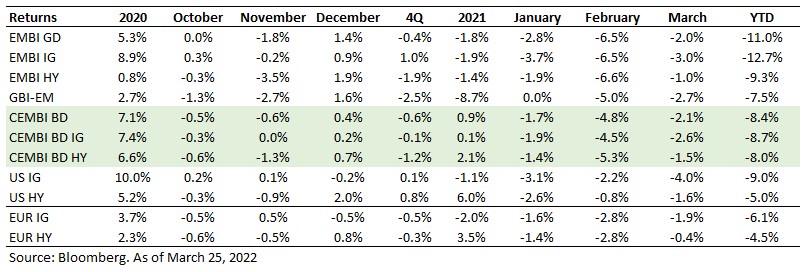
Alternative Credit
Our dynamic credit strategy seeks high, consistent returns throughout the credit cycle using a rotational approach to EM credit, which we believe can be achieved by deploying bottom-up security selection within cyclically favorable credit sectors. Our strategy target weights are roughly: 30% performing dedicated high yield, 30% performing opportunistic high yield, 20% sovereign+, and 20% distressed.
As of March 2022, the strategy is 92% invested as we have deployed capital into the current dislocation. The strategy remains skewed to performing dedicated high yield (48%) and performing opportunistic high yield (18%). We increased our exposure to sovereign+ and distressed strategies by adding positions in Lebanon, reinitiating a position in Ukraine and expanding our holdings in China property. Amidst the market turmoil, we partially monetized our interest rate, spread and oil hedges while leaving in place tail risk hedges.
What to Watch:
-
-
- Ukraine corporates are all undergoing varying degrees of stress. While it seems quite certain that all corporate bonds will need to be restructured, it seems premature to estimate what those recoveries will look like until hostilities end.
- Dislocated commodity prices – ranging from metals to energy to agriculture – will undoubtedly create stresses for commodity importing countries and commodity input corporates. Higher structural prices should make for attractive valuations for commodity producers and create (temporary) price dislocations for commodity users.
- At the end of January, Argentina and the IMF reached an agreement on a fiscal path that allows for gradual fiscal consolidation and reduction of monetary financing. While the program will only cover the next 2.5 years, it will be formally characterized as an EFF to provide BOP and budget support to address economic challenges and enhance prospects for all Argentines. The new program will include the full rollover of remaining maturities from the 2018 SBA and an approximate $4.3bn SDR reimbursement for the payments already made on the outstanding arrangement. The agreement calls for a primary deficit ceiling of 2.5% of GDP in 2022, 1.9% in 2023, 0.9% in 2024 and a primary balance by 2025. The agreement also calls for net FX reserve accumulation of $15bn through 2024, $5.8bn of which to occur this year, and reduced deficit monetization from 3.7% of GDP to 1% of GDP. Following domestic legislative approvals, final IMF board approval was provided in late March which catalyzed a $9.6bn disbursement from the Fund. Materially higher bond prices should be expected as compliance becomes less of a question mark and as we head toward presidential elections in 2023.
- Interest in Venezuela experienced a revival as the western world pivots away from Russia and seeks new strategic energy alliances. The Biden Administration sent envoys to Caracas which constituted a marked contrast from U.S. policy toward Venezuela over the last eight years. The prospect of improved relations and, perhaps, the removal of sanctions, gave risk assets a much needed shot in the arm.
- China Property continues to be under stress. Weak home sales, tight regulation and challenging financing conditions have driven prices to distressed levels. While not all weakness has been fully priced in given concerns on lackluster earnings reports, delays in financial statements, change of auditors, off balance sheet debt and rating downgrades, recoveries are likely to be substantially higher than some levels suggest. Near-term catalysts include an improvement in home sales, regulatory environment and financing conditions as well as full restructuring offers, which can provide some comfort to the market.
-
Capital Solutions
With Omicron in the rearview mirror, our Capital Solutions Team has continued to travel extensively throughout emerging markets. Despite the typical slowdown of the summer months in the southern hemisphere, deployment has kept pace putting the Team well in place to be fully invested by 1Q 2023. New deployments remain strong with new transactions funded in Colombia (financials), Brazil (agribusiness), Mexico (Energy) and Peru (infrastructure).
The global volatility caused by the war in Ukraine as well as the uncertainty surrounding the Fed’s erratic messages has prompted more borrowers to consider private financing as the public markets shy away from new issues. In this environment, the Capital Solutions Team has continued to build a solid pipeline of private credit transactions.
Also, as volatility increased, the Team has been focused on monitoring the portfolio in the context of the distortions that are present in the marketplace. As a first cut, the strategy has approximately 75% of its assets in Latin America versus only approximately 25% in CEEMEA. The Capital Solutions strategy has no investments in Russia, Ukraine, or related countries. The CEEMEA exposure is composed of three assets in Turkey and two in Africa. Turkish assets have robust collateral and immediately benefited from the increase in commodities prices.
As the Team continues to develop its pipeline and deploy capital, deals are viewed through a lens and a thorough analysis of “winners and losers”. Clearly, many Latin American borrowers who are in the commodities business are benefiting from the tailwind of higher prices. However, they are suffering from higher freight and logistical costs as well as supply chain issues. As an example, companies in the agricultural space must deal with the challenge of sourcing fertilizers away from Belarus and Russia. Others suffer from higher energy costs.
All in all, we view the current state of play as one that provides a fertile ground for our strategy to thrive. We expect to continue growing with a diversified deployment with borrowers well placed in the context of the current global landscape.
Special Situations
The Special Situations Team has developed a robust pipeline of litigation finance opportunities. We believe these opportunities feature an attractive return profile with a well-diversified collateral pool and limited litigation risk in many instances based on the litigation/settlement status of the underlying cases. The Special Situations Team is particularly focused on opportunities where the law firm and/or underlying case collateral has emerging markets (mainly Latin America) nexus, but the law firm is seeking recoveries in developed market jurisdictions including the U.S. and U.K. Underlying case collateral includes environmental, consumer protection, medical device and other product failure and personal injury cases.
Aside from these opportunities, the Team continues to consider a number of specialty finance investment opportunities. Specific opportunities currently being considered include, funding related to a large business interruption insurance claim in the Caribbean and early-stage EM litigation financing arrangements, namely under ICSID and UNCITRAL.
Where possible, the Special Situations Team is utilizing insurance products for litigation finance and other investments, which creates an asymmetric risk return profile.
Multi-Asset
Our Multi-Asset strategy came into the year well positioned with high conviction structured credit and select EMD names on one side of our barbell and opportunistic credit, special situations and a large percentage of cash on the other side. In our view, this construct performed well and now leaves us with the resilience, optionality and agility to reallocate to high return opportunities. With a dislocation well underway, we have materially reduced our hedges and are deploying cash into dislocated credit and special situations that have recently presented themselves.
In conclusion, we have witnessed and navigated the headwinds of early 2022. Given the material repricing of interest rates and subsequent dislocation in EM credit, we enter the quarter cautiously constructive. As we deploy capital this quarter, we will look to identify the credits that are on the right side of anticipated dispersion and avoid those that will be more challenged. We will continue to be dynamic with our asset allocation, a condition that is not only desirable but necessary in the markets we face today. In doing so we will continue to be guided by the top-down and bottom-up analysis that has served us well and respect and embrace volatility by planning the trade and trading the plan.
About Gramercy
Gramercy is a dedicated emerging markets investment manager based in Greenwich, Connecticut with offices in London, Buenos Aires and Mexico City, and dedicated lending platforms in Mexico, Turkey, Peru, Pan-Africa, Brazil, and Colombia. The firm, founded in 1998, seeks to provide investors with attractive risk-adjusted returns through a comprehensive approach to emerging markets supported by a transparent and robust institutional platform. Gramercy offers alternative and long-only strategies across emerging markets asset classes including multi-asset, private credit, public credit, and special situations. Gramercy is a Registered Investment Adviser with the SEC and a Signatory of the Principles for Responsible Investment (PRI). Gramercy Ltd, an affiliate, is registered with the FCA.
Contact Information:
Gramercy Funds Management LLC
20 Dayton Ave
Greenwich, CT 06830
Phone: +1 203 552 1900
www.gramercy.com
Joe Griffin
Managing Director, Business Development
+1 203 552 1927
[email protected]
Investor Relations
[email protected]
This document is for informational purposes only, is not intended for public use or distribution and is for the sole use of the recipient. It is not intended as an offer or solicitation for the purchase or sale of any financial instruments or any investment interest in any fund or as an official confirmation of any transaction. The information contained herein, including all market prices, data and other information, are not warranted as to completeness or accuracy and are subject to change without notice at the sole and absolute discretion of Gramercy. This material is not intended to provide and should not be relied upon for accounting, tax, legal advice or investment recommendations. Certain statements made in this presentation are forward-looking and are subject to risks and uncertainties. The forward-looking statements made are based on our beliefs, assumptions and expectations of future performance, taking into account information currently available to us. Actual results could differ materially from the forward-looking statements made in this presentation. When we use the words “believe,” “expect,” “anticipate,” “plan,” “will,” “intend” or other similar expressions, we are identifying forward-looking statements. These statements are based on information available to Gramercy as of the date hereof; and Gramercy’s actual results or actions could differ materially from those stated or implied, due to risks and uncertainties associated with its business. Past performance is not necessarily indicative of future results. This presentation is strictly confidential and may not be reproduced or redistributed, in whole or in part, in any form or by any means. © 2022 Gramercy Funds Management LLC. All rights reserved.
